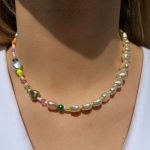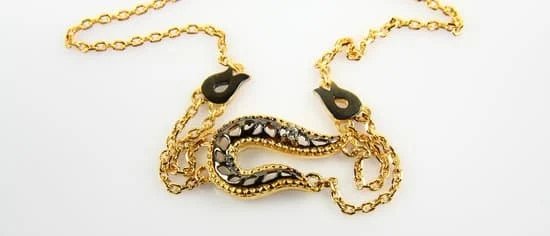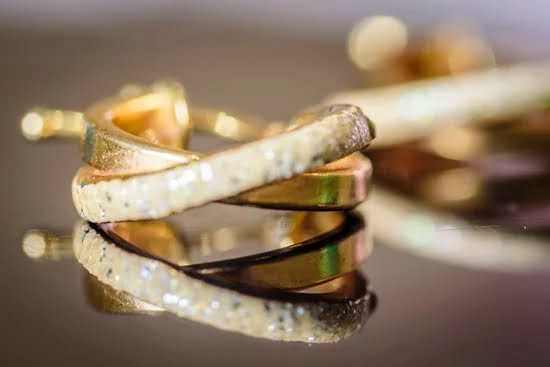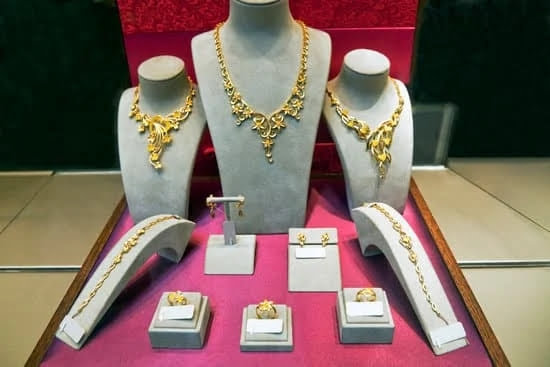Jewelry tarnishing is the gradual corrosion of metal pieces due to environmental factors such as humidity and chemical exposure. Tarnishing usually occurs when jewelry is made from unprotected, non-precious metals like silver, gold, bronze, brass, or tin. Silver is especially prone to this type of oxidation because it has limited resistance to carbon dioxide and water in the air.
As a result, the surface of silver jewelry begins to corrode and take on a dull gray color. Depending on how advanced the tarnish is, there are several tried-and-true methods for removing the layer of oxidation from your jewelry.
Homemade Remedies – DIY Methods
The first step in tackling your tarnished jewelry is to identify which type it is-whether it be silver or some other metal – so that you can choose the right remedy based on its composition. Common items such as baking soda, aluminum foil, vinegar, lemon juice or club soda are often used to clean various types of surfaces. For instance, mixing equal parts baking soda and white vinegar can create an effective solution for cleaning silver jewelry.
Since both ingredients are harmless to skin and safe when exposed to everyday usage in small quantities they make good natural cleaners for jewelry at home. All you have to do is submerge your tarnished piece into the paste-like solution for 12 minutes then rinse with warm water and let dry before storing away safely once again.
Polishing Cloths – Professional Cleaners
For those looking more professional results you can opt for polishing cloths that specifically remove abrasive dirt and oils from precious metals like gold or silver. These cloths contain special cleansing agents that work quickly on reflective surfaces and are easy to use with just a few swipes.
They also leave behind a protective wax coating which helps deter further deterioration caused by pollutants in the environment – keeping your bling solo fresh and shiny for longer. Simply rub over your tarnished jewelry with small circular motion until all residue has been removed then buff off any excess product before putting it back into storage.
How To Spot Tarnishing
Tarnishing occurs when metal jewelry comes in contact with air or other substances that cause the metal to oxidize, resulting in a discoloration on the surface. The location of tarnish often depends on the type of metal used. Silver tarnishes on the surface, whereas brass and copper tend to darken from within.
Gold is less reactive but may occasionally require cleaning. Along with a discoloration, you might notice a subtle change in texture as well; for example, silver may take on a soft matte finish after oxidizing compared to its original glossy shine.
Once your pieces of jewelry have been identified as tarnished, it’s time to begin the repair process. Depending on the extent and type of discoloration you can use several methods to restore the luster back into your favorite accessories.
If you have a piece of jewelry made from sterling silver and it has light tarnishing, an over-the-counter silver cleaner is usually enough to do the trick. Place the item into a bowl filled with polish and rub gently using an old toothbrush.
As an alternative – and solely for fine silvers – fill another bowl with warm water mixed with a dash of liquid detergent and dab gently until dirt and grime are removed from between the intricate patterns carved onto them. Rinse off any residue and dry gently before storing away securely.
For slightly heavier tarnish or for those made of copper or brass, create a paste out of baking soda (or non-gel toothpaste) and white vinegar combined with warm water which creates bubbles as it starts reacting to together instantly when combined together.
Rub this onto all affected areas – – like cufflinks, bracelets, necklace forms – – using either an old clean towel or cotton cloth before rinsing off the entire item thoroughly under running water until then entire Polish paste is gone completely.
Allow 72 hours for everything to dry completely before storing away safely again so oxidation won’t occur further down the line again due lack of proper maintenance – meaning where exposed sunlight/heat sources are present at time intervals without continual turning often enough over prolong period left untouched would result in too much exposure otherwise still.
What Supplies Are Needed for Jewelry Repair
When it comes to jewelry repair, you need to have the right supplies on hand. Jewelry repair can involve a number of things such as fixing broken stones, prongs and chains. It can also mean restoring tarnished items by removing tarnish and dirt in order to restore the luster of any piece. When it comes to jewelry repair, you’ll need cleaning solutions, polishing cloths and other necessary tools.
A basic jewelry tool kit is essential for all types of jewelry repair. This will include pliers, tweezers, wire cutters and files of various sizes in addition to a variety of cleaning solutions that can be used for different types of metals.
Polishing cloths are also recommended for bringing back the shine in silver or gold pieces since these surfaces tend to be prone to tarnishing over time. Depending on the item being fixed, other specialized tools may be needed such as diamond faceting machines or magnifying glasses with extra powerful magnification power.
If your pieces are heavily tarnished or corroded from long term exposure, then chemical bath cleaners can be used as an alternate method to remove stubborn stains or corrosion that could otherwise cause permanent damage.
These cleaners are designed specifically for dealing with this kind of situation and should only be used if absolutely necessary as they are incredibly strong chemicals that should always be used in well-ventilated areas with proper safety equipment like goggles and masks set up accordingly.
Generally speaking however, a regular polishing cloth will take care of most minor cases of metal oxidation without having to resort to more extreme measures like metal baths or abrasives.
Easy Cleaning Solutions for Simple Jewelry Care
Taking proper care of jewelry, like any cherished accessory, can keep it sparkling and vibrant for years. Most pieces are made from metals, some of which require special cleaning techniques to bring back their luster. Tarnished jewelry is a common issue and is fairly easy to repair.
To repair jewelry with tarnish there are several methods that can be done at home; my favorite being to use an aluminum plate and baking soda. The aluminum plate allows for a science experiment in jewelry treatment.
When using this method, begin by laying the aluminum on an even surface and sprinkle a teaspoon of baking soda directly over the middle. Then lay the tarnished piece or pieces on top of the baking soda but make sure the silver part is resting directly in contact with the aluminum.
With it now secured in place, pour over 6 ounces of hot water onto the baking soda. An effervescent reaction will take place between the two materials and when fully reacted you will essentially have a sulphite solution that has dissolved some of the tarnish off your prized jewelry piece (s).
Once completed, rinse off both surfaces of each piece with mild soap and room temperature water then set out to dry naturally or lightly pat dry with polishing cloths. Be careful not to rub aggressively as this could cause discoloration or further wear and tear down on the item itself.
After drying your newly cleaned jewelry should look brand new again. This works especially well on silver jewellery such as rings and necklaces but depending on how worn down or corroded your accessories are you may need to be more aggressive if this method does not provide desired results; consider using a professional cleaner if needed.
If you found success from using this method give yourself a pat on the back as now your jewelry is back with it as good as new condition – bravo. No one likes wearing dull accessories so be sure to keep up regular cleaning routines in order to maintain its brilliance.
Selecting the Best Jewelry Cleaning Method for the Material
It’s important to select the proper cleaning method for each material when repairing tarnished jewelry. Take into consideration any possible damages that may occur. Gold is easy to clean with jewelry cleaner, but silver needs to be treated differently because it’s tempered at a lower heat or it will wear away. Some jewelry experts also suggest using different cleaners for gold, silver and any gemstones incorporated in a piece of jewelry.
Gold Jewelry Cleaning
Gold is a durable metal, so it can take many abrasives safely without damage. To repair tarnished gold jewelry, start by filling a bowl or shallow dish with warm water and mild detergent before stirring. Place the jewelry in the water and allow it to soak until the dirt comes off easily.
Following this, use an old toothbrush or soft cloth dipped in soapy water such as Dawn® soap or other gentle dishes soap to gently scrub soil from hard-to-reach places like crevices or intricate settings on the piece. For polishing specific problem spots you can use a paste made from baking soda and hydrogen peroxide – this should amplify its shine.
Silver Jewelry Cleaning
When it comes time to repair silver tarnish there are different approaches to go about cleaning this kind of delicate metals so as not to damage its integrity or age prematurely. Start by preparing a solution of warm water and baking soda mixed together in equal parts then dip either an old toothbrush or cotton cloth into softened solution before carefully scrubbing all sides of the silver jewelry item(s).
This will help remove any grime while keeping the luster intact – just make sure no harsh chemicals are used during the cleaning process.
Afterwards rinse with cold running water before you buff dry with a soft cloth for extra sparkle and shine factor. If possible try using distilled white vinegar instead which does wonders for removing blemishes too.
Gemstone Jewelry Cleaning
Gemstones often require more attentive care when cleaning due to their fragile constitution; these precious stones must be handled carefully in order for them not to become damaged at all costs. Carefully inspect jewellery before adding gemstone pieces – only general cleaning solutions should be used here, so no harsh chemicals that may damage your item(s) should come into contact with them whatsoever.
If necessary use very light pressure when directly brushing any accumulated dirt off these areas however do not place these directly into soaking solutions since they may react denaturing effects as well.
Lastly blotting motion with dampened cotton swab will often do good job at decisively removing any remaining debris trapped within nooks and crannies present on items of this nature swiftly before being buffed off with another similarly moisture free cloth afterwards; anything beyond that may risk damaging sensitive surface textures found adorning gems present in the piece(s).
Proper Use of Polishing Cloths on Tarnished Jewelry
Polishing cloths are one of the most popular methods for restoring tarnished jewelry. When you have jewelry with a high silver content, polishing can bring back its luster quickly and easily.
Before starting the process, it is important to make sure that you use the appropriate type of cloth for your jewelry. You may want to invest in a specific cloth designed specifically for that kind of material.
Cloths made specially for silver are ideal, but may also be available in other colors such as gold, bronze or copper. It’s also key to consider what type of finish is on your jewelry before cleaning it – some finishes must not be buffed or rubbed vigorously, so check with a reliable source prior to using any materials.
After selecting the right cloth and determining which method will work best for your item, begin slowly and gently rubbing the cloth over your piece until it regains its original luster. Take extra care when applying pressure around any gemstones embedded in the piece-polish lightly and avoid rubbing on them too hard as this can result in scratching or even crackling of their surface.
Additionally, be mindful that many items with stones may have an additional coating applied by the jeweler after setting-avoid polishing on these areas as much as possible since doing so could strip away this protective layer entirely leaving them exposed and vulnerable to damage.
It’s always important to stay mindful about how much time you spend completing this task; scrubbing too hard or for too long can end up damaging your precious gems. To ensure maximum results from polishing, avoid taking shortcuts and work carefully instead-this way you will restore tarnished jewelry without creating more harm than good.
Repairing Jewelry with Specialty Tools or Techniques
Tarnishing is the result of an oxidation process caused when moisture and oxygen mix with certain metals, leaving a black or brown film on jewelry. Luckily, repairing tarnished jewelry can be surprisingly easy. There are certain tools and techniques that can be used to restore your jewelry to its original luster, including using polishing cloths and dipping solutions.
Polishing Cloths are one of the easiest methods for removing the tarnish from your jewelry. You may need to use more than one if there is a greater build up of tarnish on your piece.
All you have to do is rub the surface of your jewelry with the cloth until it reaches its original shine. It’s best to keep track of progress as you go so that you don’t over-polish or damage areas that aren’t tarnished.
If polishing cloths aren’t doing the job then a silver dip might be necessary. Silver dips are available at most craft stores and have chemicals in them designed specifically to remove tarnish from silver items such as jewelry.
To use them, begin by making sure all stones are removed from your piece and then submerge it in the dip for around five minutes before rinsing off in cold running water and drying with a delicate cloth. If this doesn’t work, try leaving your item in the dip for up to fifteen minutes instead.
If even these two techniques won’t work on particularly stubborn patches of tarnish then you may want to consider taking it to a jeweler for more specialised care. A professional can generally remove any trace of patina with an ultrasonic cleaning solution or steam cleaner, but this should only be used as a last resort since strong solution can weaken some stones or even discolor them altogether.
Conclusion
Jewelry can be a precious and personal item, and the last thing anyone wants is for their pieces to become damaged or tarnished over time. Thankfully, those who own jewelry made from gold, sterling silver, or other materials that tend to tarnish have specific methods they can use to repair and restore it. From polishing cloths to baking soda, toothpaste, or a jewelry cleaning cleaning solution, there are plenty of options for cleaning tarnished jewelry.
At the same time as repairing your jewelry however it’s important to also consider what steps you should take for preventative care in order to make sure that it doesn’t happen again. For example, avoiding contact with water or certain types of chemicals can help stop the build-up of tarnish on your silver items.
Similarly, limiting direct exposure to the sun’s UV rays can help protect gold plating from wearing away too quickly. Jewelry boxes are a great way to store your items too since they will keep them safe and out of reach of harmful elements.
Another suggestion could be protecting your items if you’re doing activities such as yard work or working with chemicals at home; wear non-metallic gloves which help prevent buildup on your rings or any other pieces where skin acidity would normally corrode metal. Keeping pieces stored in zippered bags when not worn is another good idea because this will trap away any air molecules which might damage its surface beneath layers of plastic.
Finally ensuring that you regular clean them (every 6-12 months) goes a long way towards helping maintain their luster and is worth considering. All these precautions combined will significantly help minimize tarnish build up on continue keeping your jewelry looking brand new.

Welcome to my jewelry blog! My name is Sarah and I am the owner of this blog.
I love making jewelry and sharing my creations with others.
So whether you’re someone who loves wearing jewelry yourself or simply enjoys learning about it, be sure to check out my blog for insightful posts on everything related to this exciting topic!





